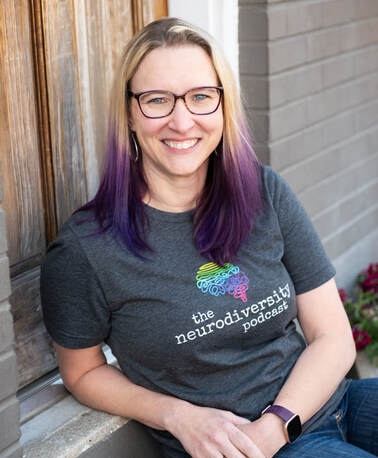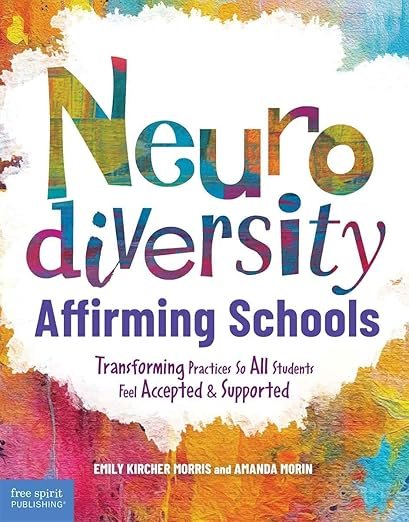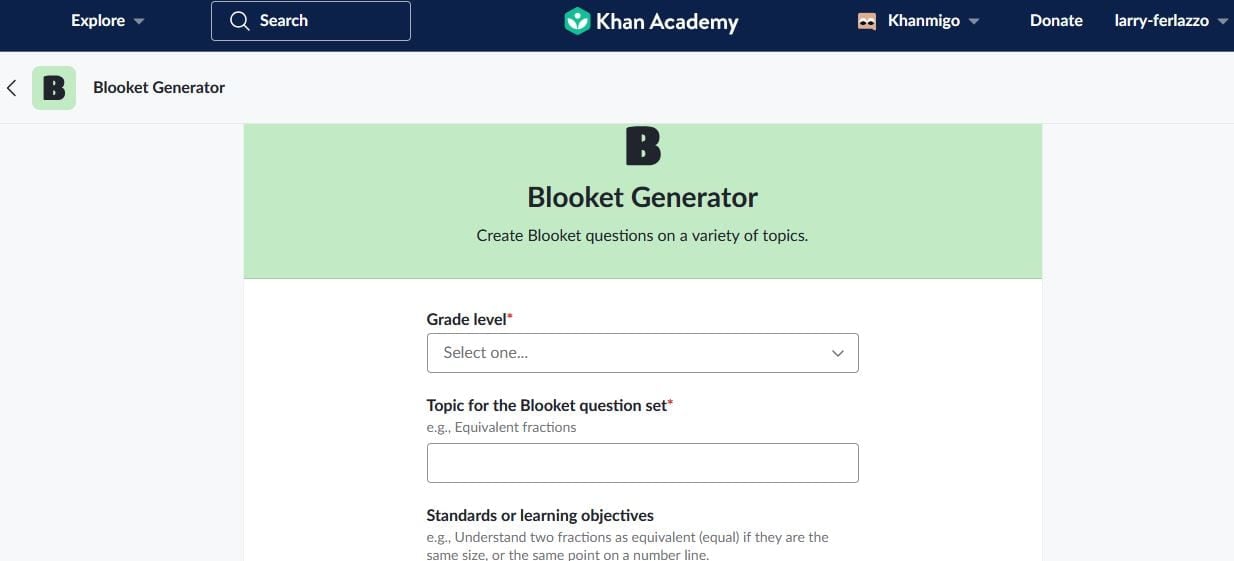
Listen to the interview with Amanda Morin and Emily Kircher-Morris (transcript):
Sponsored by Boclips Classroom and Brisk Teaching
This page contains Amazon Affiliate and Bookshop.org links. When you make a purchase through these links, Cult of Pedagogy gets a small percentage of the sale at no extra cost to you. What’s the difference between Amazon and Bookshop.org?
Over the last 10 years or so, the word “neurodivergent” has become a more common part of our everyday language. And while not everyone agrees on an exact definition of this umbrella term, it’s frequently used to describe people who are on the autism spectrum, people with learning disabilities, and people with attention differences like ADD and ADHD, among others. As our understanding of the human mind gets more sophisticated and nuanced, we are learning how to identify neurodivergence, how to appreciate it, and how to help those who fit under that umbrella navigate the world better.
One place where that process has been happening quite a lot is in schools; we’ve definitely made progress with neurodivergent students. But the progress has been spotty, and it’s also framed our population in a sort of binary way, with “neurodivergent” students on one side and “everyone else” on the other. The adjustments made in schools are often treated as special accommodations made for a special few. But one of the things we’re learning about neurodivergence is that it’s not necessarily an either/or; it’s not that you’re either 100% neurodivergent or you have a standard-issue “normal” brain. The way our brains are wired puts all of us somewhere on a spectrum, or a few spectrums, really, with each individual person having their own unique wiring.
And that’s why the title of this post uses the term neurodiversity instead of neurodivergent. This shift in language acknowledges that everyone’s brain is different, and if we set up our schools in a way that makes room for many variations, we’ll all be better off.
To help us learn some simple ways we can create those schools are Amanda Morin, a neurodivergent neurodiversity activist, author, early childhood specialist, and speaker, and Emily Kircher-Morris, a mental health professional, neurodiversity advocate, author, and host of The Neurodiversity Podcast. Together, Morin and Kircher-Morris have written a book, Neurodiversity-Affirming Schools: Transforming Practices So All Students Feel Accepted & Supported (Amazon | Bookshop).
The book offers all kinds of specific guidance that will help teachers reshape their classrooms into places that offer flexible options for students with a wide range of “wiring.” On the podcast they shared four actionable changes you can make right now that will begin that reshaping. You can listen to our conversation in the player above, read the full transcript here, or take a look at the highlights below.
Q: You use the term neurodiversity instead of neurodivergent. Why is that?
Morin: Neurodiversity is all of us, all of our brains. The whole world is neurodiverse. So when we were thinking about what makes a neurodiversity affirming school, we weren’t just thinking about what makes a school open and fosters a sense of belonging for neurodivergent students. We were thinking about how do you create an environment for not just your neurodivergent learners, but all the learners in your classroom? How are you celebrating all of the different neurotypes that show up and working with the brains that you have in your classroom? There are going to be different types of learners in your classroom who don’t meet the threshold or the criteria for an IEP or 504 plan.
Kircher-Morris: So many neurodivergent learners may never qualify for an individualized education plan because the educational criteria for that identification is is very rigid in many ways. Regardless, all of those students are in our classrooms. They’re all there with us and they all have those different needs.
Morin: It doesn’t matter necessarily what the criteria is. We need to support where they need to grow and we need to celebrate where they have strengths.
Q: I hear this question a lot, so let’s get it out of the way: Why is it that “all of a sudden” so many people have a diagnosis of neurodivergent?
Kircher-Morris: It wasn’t that neurodivergent people weren’t there before, it’s just that they weren’t being labeled. The diagnostic processes that we use to find these labels has shifted significantly over the last couple of decades.
Morin: The word neurodivergent has really evolved to to include other things under that umbrella. it’s not just autism anymore. It’s not just ADHD. It’s things like dyslexia and other learning disabilities. And there are other things that fall into that. We’re expanding the definition as people realize how the variations of their neurological wiring impact their ability to sort of function in the world.
Kircher-Morris: There’s also been a process of de-stigmatizing and de-pathologizing which has allowed people to to seek this self-understanding a little bit more. Awareness has increased, stigma has decreased.


The Four Changes
Taking steps to implement these changes can make a big difference in how neurodiverse students experience your classroom; you may find you’re already doing some of them.
Change 1: Stop Insisting on Eye Contact
Morin: For many neurodivergent students, it actually can be very distracting to ask somebody to look you in the eyes. They’re distracted by all of the other things that are going on or that they’re trying to figure out. Their brain is literally distracted. There’s research that shows that when you ask an adult a really difficult question, 85% of the time they’ll look off and try and think about it. Our students are doing the same thing. We shouldn’t be asking our students to do things that we can’t do ourselves.
I think we insist on eye contact because we feel like it shows that somebody is paying attention to us. But there are other ways that we can ask them to show that. We can ask them, what is the way that I will know when you’re paying attention? How can we indicate? Let’s ask our students what’s most comfortable for them, and let’s figure out how else we can see that they’re paying attention. And challenge our own thoughts about why do I need someone to look me in the eye?
Kircher-Morris: Sometimes we will ask a student, like, “Well, look at my nose,” like kind of fake making eye contact. What we have to realize when we’re doing that, all we are doing is teaching them to mask or camouflage what kind of makes them different. And it doesn’t necessarily help them. It’s not helping them feel more comfortable. That’s about making the other person feel more comfortable. And at what expense? If that causes more anxiety, if they actually get less from that interaction, wouldn’t it be better to teach that student to self-advocate and say, it’s actually much easier for me to focus on what you’re saying when I’m looking at the floor rather than looking at your face?
Change 2: Revisit Your Assessment Practices
Kircher-Morris: We need to really make sure that when we are assessing something, we’re assessing what we are actually wanting to assess. For example, there are many elementary schools that still use timed tests as a way to increase math fluency for math facts. The problem with that is what are you actually assessing there? Are you assessing math fluency — that retrieval where it’s immediate as opposed to the calculation? Or are you assessing a student’s processing speed and their working memory? Those are two very different things. And many of the practices that we put into place are not actually always measuring the thing that we say that we’re measuring.
Another example for this would be do you give participation points in your classes? And what does that look like? For a student who is neurodivergent, perhaps you have the ADHD-er who is very impulsive and monopolizes a conversation. Depending on how you’re grading that participation, that might not look the way you want it to. For a student who’s more quiet and reserved where they have a harder time jumping in (or) a student who has slower processing speed, sometimes when you have group conversations, those conversations move so quickly that they’ll tell you it’s like By the time I come up with the thing I want to say, the conversation has already moved on and I haven’t had a chance. If you’re assessing them and taking participation points away, then that’s a barrier.
We want to look at accommodations and make sure that we are able to measure that they’re actually accomplishing what the objective is of that task. What is the goal that we are trying to actually see if they’re able to do or that they’ve mastered a particular skill?
Change 3: Be More Explicit
Morin: I had a student say to me, I really don’t like it when we do the whole activity and then by the end of the lesson they’re like, “and what we learned today was…” If the teacher had flipped that and started with “what we’re going to learn today and we’re going to learn it through this activity,” that student would have been more engaged. They would have been more bought in to doing the lesson, but he spent the entire period trying to figure out why are we doing this? The explicitness of why are we doing this matters a ton to our students.
Let’s be explicit in how we provide instructions and give the opportunity for students to ask clarifying questions. Let’s be really direct as much as we possibly can and tell them this is what it will look like when it’s done or this is what I’m expecting or here’s the rubric I’m using. Providing instructions in multiple ways, showing exemplars of what things can look like, giving rubrics, giving checklists, all of those handy helper kinds of things are part of that being explicit because it also recognizes the fact that not everybody’s processing information verbally, and not everybody’s processing information in written form.
All of these are practices a lot of teachers use already, but saying it out loud and naming it as neurodiversity affirming really reframes for you that you’re already doing some of these things in your classroom.
Change 4: Shift From Compliance-based to Context-based Interpretation of Behavior
Kircher-Morris: Many educators I know out there have heard the phrase “All behavior is communication.” For our neurodivergent kids, if you have a student who appears like they’re being rude or they’re defiant or they’re not paying attention, instead of immediately going to that knee jerk, “You’re not following the rules” or whatever that might be, we need to check ourselves and recognize our own triggers, the things that elevate our own emotions and how we react to that with students. Then just taking a minute and going, instead of reacting, I’m going to respond. I need to pause and try to figure out what’s really going on here. And then find a solution. Because ultimately the problem with any of those compliance-based outcomes — which typically are disciplinary actions — you’re not actually helping that student understand what they’re supposed to do if that situation comes up again anyway. They just know that they got in trouble for it.
Morin: You can’t punish skills into action. You can teach skills, but you can’t punish somebody into having skills.
A Conversation About Teacher Overwhelm and Inclusion
Near the end of our conversation, I asked my guests to weigh in on a problematic scenario I’ve been hearing more about lately, where higher-need students are being placed in classrooms, often at parents’ request, with teachers who have none of the training or support necessary to meet those students’ needs. I brought this up because I think situations like these are making classroom teachers more resistant to the kind of things Emily and Amanda are advocating for in their book — possibly making teachers view any and all decisions made in the spirit of inclusion as beyond their skill set, when in fact, all of the changes they propose are pretty doable.
Morin: I think a lot of times when IEP teams and parents are thinking about least restrictive environment, they’re thinking about the place where the learner learns. (But) least restrictive environment isn’t always a place. It’s an instructional model. It’s how does that instruction get put into place? The support staff matters; having that support staff who can really support the needs of the learner and balance the teacher’s other responsibilities matters a lot.
The language of the law is to put students with disabilities in a place to learn to the maximum extent appropriate, including with students who are not disabled. That’s the language of the law, and we take that language very, very literally sometimes. Okay, so this student needs to be in a classroom, a general education classroom, with students who are not disabled. But the language of the law is different than the intent, and the intent is to make sure they have an opportunity to access that curriculum, to access education in the same ways as students who are not disabled. That does not always mean in the general education classroom. What we’re talking about is how are we making sure that students have the opportunity to interact with all of their peers, but also learn.
That’s a conversation that you can have as a team, to acknowledge parents’ fears about their students being segregated; it is a fearful place to be. But I think reframing it as, when can my child be in a classroom with non-disabled peers and have meaningful access to learning? And when are there opportunities to provide them with more meaningful access to learning? And how does that in itself support our teachers in feeling like they have a sense of self-efficacy? Teachers need to feel like they can teach the students who are in their classroom. And sometimes that also means putting into an IEP training and support for a teacher.
(Teachers need) the language to reframe it and to say, I really want this learner to be successful. I want all the learners in my classroom to be successful. And I want to be successful. It’s very different than saying this child doesn’t belong in my classroom.
How These Shifts Could Impact Our Future
To close our interview, I asked Morin and Kircher-Morris to share their thoughts about what our schools and societies would look like in ten or twenty years if we made more intentional changes like these now.
Kircher-Morris: In a utopian world, in our schools, I would love that we didn’t even need all of these labels and that we would just have systems and supports in place so that any student who needed them was able to access them. Right now (labels) are often necessary in order to to find those supports, but also they can be a barrier for people who maybe can’t access those labels or identifications for a variety of reasons. I think also just the changes in part of the school’s fabric as far as normalizing accommodations and understanding those unique ways of communicating and experiencing the world, like those are not less than, they’re just different from, and we can value those as well as all of these other differences that we see in our kids.
Morin: And when we do that, as we change systems in education, we’re changing societal systems too. In this utopian world, once we have raised students who are empowered and neurodivergent students who know how to speak up for the accommodations they need, then we are also building a society that is going to have hopefully reduced ableism in their hiring practices. We’re going to be hiring those people who don’t look you in the eye when they have that conversation because they have the skills and you can see that they have the skills to do the job. And that we are more aware and our neurodivergent students feel more confident that they can navigate the world once they’re out of school.
Kircher-Morris: The more we put into place processes that are accommodating for all students, we actually will build the systems that allow all of those students to be more successful in varied environments.
To learn more from Morin and Kircher-Morris, check out their Neurodiversity University Educator Hub. Cult of Pedagogy readers use the code CULT to get 50% off the first month.
The post Small Changes to Make Your Classroom More Neurodiversity-Affirming first appeared on Cult of Pedagogy. Everyone’s brain is different, and if we set up our schools in a way that makes room for many variations, we’ll all be better off.
The post Small Changes to Make Your Classroom More Neurodiversity-Affirming first appeared on Cult of Pedagogy. Equity, Instruction, Podcast, ADHD, special education Cult of Pedagogy





